Spatial Distribution of Leisure Agriculture in Xinjiang and Its Influencing Factors Based on Geographically Weighted Regression
Abstract
1. Introduction
1.1. Leisure Agriculture and Sustainability
1.2. Geographically Weighted Regression
2. Materials and Methods
2.1. Overview of the Study Area
2.2. Data Sources
2.3. Methods
2.3.1. Nearest-Neighbor Index
2.3.2. Geographic Concentration Index
2.3.3. Imbalance Index
2.3.4. Kernel Density Analysis
2.3.5. Standard Deviation Ellipses
2.3.6. Geographically Weighted Regression
2.3.7. Lorenz Curve
3. Analysis and Results
3.1. Analysis of Spatial Distribution
3.1.1. Type of Spatial Distribution
3.1.2. Equilibrium of Spatial Distribution
3.1.3. Spatial Distribution Density
3.2. Factor Selection
3.3. Model Construction
3.4. Analysis of Effects
3.4.1. Rainfall Factor
3.4.2. Population Factors
3.4.3. Traffic Factors
3.4.4. Tourism-Resource Factors
3.4.5. City Distribution Factors
4. Discussion
5. Conclusions
- (1)
- The spatial distribution of the leisure agriculture spots in Xinjiang was uneven. The distribution was concentrated to the north and south of the Tianshan Mountains, in western Xinjiang. The number of sites varied significantly between different locations, with more than half of the sites concentrated in Ili and north-western Bazhou and fewer in Kezhou, Karamay, and Turpan.
- (2)
- In terms of the spatial distribution density, four high-concentration centers and one secondary concentration center were identified. The four high-concentration centers were located near Bosten Lake, in Hami, and on the east and west sides of the Ili River Valley. The secondary concentration center was located in Urumqi and radiated outward toward the surrounding areas. Overall, the leisure agriculture in Xinjiang was found to be distributed, predominantly, on either side of the Tianshan Mountains and in the Ili River Valley in the west. The overall number of sites decreased to the south.
- (3)
- Seven factors were selected and used to quantify the variability of their effects using OLS and GWR. The results revealed that the population, transportation, tourism resources, city distribution factors, and rainfall factors had significant effects on the distribution of the leisure agriculture. According to the positive and negative values of the regression coefficients, all of the factors had negative and positive effects on the distribution of the leisure agriculture and formed high- and low-value areas. This indicates that there was significant local variability in the degree and direction of the influences of the factors on the distribution of the leisure agriculture. The effects of the topography and economy on the distribution of leisure agriculture were not obvious.
- (4)
- The leisure agriculture had different degrees of response to the different factors, exhibiting considerable internal variability. Compared with the other factors, the spatial variability of the effects of rainfall on the spatial distribution of the leisure agriculture were greater, with a considerable proportion of both positive and negative effects. The traffic, urban, and tourism-resource factors all had consistent effects on the distribution of the leisure agriculture. The directional effects were largely positive, with positive regression coefficients in more than 80% of the study area. The population factors, on the other hand, are dominated by negative effects. In terms of the range of the geographical effects, the positive high-value areas of the rainfall factor were distributed in western Xinjiang in the Ili Valley, Kezhou, and Bortala. The negative values were primarily distributed in eastern Xinjiang in Urumqi, Turpan, and Hami. The negative areas for the population factors accounted for a large proportion. The high regression coefficient values of the traffic factor were centered on the north-western part of Bazhou and the values decreased, outward, in a belt-like manner. For the urban factor, Bosten Lake and the Ili Valley in Bazhou were the positive high-value concentration areas. The positive values were also distributed in Altai, in the north and Hami in the east, with a negative value center forming a ring around Urumqi, Changji, and Turpan. The positive high-value areas of the tourism-resource factors were distributed along the border in eastern Xinjiang. In addition, a belt-like high-value area was formed from the south-eastern part of Bazhou, toward the Ili Valley.
Author Contributions
Funding
Institutional Review Board Statement
Informed Consent Statement
Data Availability Statement
Acknowledgments
Conflicts of Interest
References
- Pillay, M.; Rogerson, C.M. Agriculture-tourism linkages and pro-poor impacts: The accommodation sector of urban coastal KwaZulu-Natal, South Africa. Appl. Geogr. 2013, 36, 49–58. [Google Scholar] [CrossRef]
- Ma, X.; Han, M.; Luo, J.; Song, Y.; Chen, R.; Sun, X. The empirical decomposition and peak path of China’s tourism carbon emissions. Environ. Sci. Pollut. Res. 2021, 28, 66448–66463. [Google Scholar] [CrossRef] [PubMed]
- Dodman, D.; Rhiney, K. “We nyammin?” food supply, authenticity, and the tourist experience in Negril, Jamaica. In New Perspectives in Caribbean Tourism; Routledge: New York, NY, USA, 2008; pp. 115–133. [Google Scholar] [CrossRef]
- Ćirić, M.; Tešanović, D.; Kalenjuk Pivarski, B.; Ćirić, I.; Banjac, M.; Radivojević, G.; Grubor, B.; Tošić, P.; Simović, O.; Šmugović, S. Analyses of the Attitudes of Agricultural Holdings on the Development of Agritourism and the Impacts on the Economy, Society and Environment of Serbia. Sustainability 2021, 13, 13729. [Google Scholar] [CrossRef]
- Vasadze, M. The Role of Agritourism in Sustainable Rural Development of Georgia. China-USA Bus. Rev. 2020, 19, 141–147. [Google Scholar] [CrossRef]
- Klak, T. Tourism and agriculture: New geographies of consumption, production and rural restructuring. J. Lat. Am. Geogr. 2012, 11, 183–184. [Google Scholar] [CrossRef]
- Asiedu, A.B.; Gbedema, T.K. The nexus between agriculture and tourism in Ghana: A case of underexploited development potential. In Tourism and Agriculture: New Geographies of Production and Rural Restructuring; Routledge: London, UK, 2011; pp. 28–46. [Google Scholar]
- An, W.; Alarcón, S. How Can Rural Tourism Be Sustainable? A Systematic Review. Sustainability 2020, 12, 7758. [Google Scholar] [CrossRef]
- Guo, Y.; Jiang, J.; Li, S. A Sustainable Tourism Policy Research Review. Sustainability 2019, 11, 3187. [Google Scholar] [CrossRef]
- Tang, C.; Wan, Z.; Ng, P.; Dai, X.; Sheng, Q.; Chen, D. Temporal and spatial evolution of carbon emissions and their influencing factors for tourist attractions at Heritage tourist destinations. Sustainability 2019, 11, 5944. [Google Scholar] [CrossRef]
- Amsden, B.; McEntee, J. Agrileisure: Re-imagining the relationship between agriculture, leisure, and social change. Leis. Loisir 2011, 35, 37–48. [Google Scholar] [CrossRef]
- Long, H.; Zhang, Y.; Tu, S. Rural vitalization in China: A perspective of land consolidation. J. Geogr. Sci. 2019, 29, 517–530. [Google Scholar] [CrossRef]
- Liu, Y.; Guo, Y.; Zhou, Y. Poverty alleviation in rural China: Policy changes, future challenges and policy implications. China Agric. Econ. Rev. 2018, 10, 241–259. [Google Scholar] [CrossRef]
- Yang, J.; Yang, R.; Chen, M.-H.; Su, C.-H.J.; Zhi, Y.; Xi, J. Effects of rural revitalization on rural tourism. J. Hosp. Tour. Manag. 2021, 47, 35–45. [Google Scholar] [CrossRef]
- Li, J.; Liu, Y.; Yang, Y.; Jiang, N. County-rural revitalization spatial differences and model optimization in Miyun District of Beijing-Tianjin-Hebei region. J. Rural Stud. 2021, 86, 724–734. [Google Scholar] [CrossRef]
- Chen, Y.; Wen, C.; Xu, X. The COVID-19 Impact on Population Flow of Ethnic Minority Areas. J. Univ. Electron. Sci. Technol. China 2021, 50, 938–946. [Google Scholar] [CrossRef]
- Boccia, F.; Sarnacchiaro, P. Chi-squared automatic interaction detector analysis on a choice experiment: An evaluation of responsible initiatives on consumers’ purchasing behavior. Corp. Soc. Responsib. Environ. Manag. 2019, 27, 1143–1151. [Google Scholar] [CrossRef]
- Wu, H.C.; Lin, Y.C.; Chen, T.C.T. Leisure Agricultural Park Selection for Traveler Groups Amid the COVID-19 Pandemic. Agriculture 2022, 12, 111. [Google Scholar] [CrossRef]
- Roman, M.; Grudzień, P. The Essence of Agritourism and Its Profitability during the Coronavirus (COVID-19) Pandemic. Agriculture 2021, 11, 458. [Google Scholar] [CrossRef]
- Nie, J.; Kiminami, A.; Yagi, H. Exploring the Sustainability of Urban Leisure Agriculture in Shanghai. Sustainability 2022, 14, 4813. [Google Scholar] [CrossRef]
- Martínez, J.M.G.; Martín, J.M.M.; Fernández, J.A.S.; Mogorrón-Guerrero, H. An analysis of the stability of rural tourism as a desired condition for sustainable tourism. J. Bus. Res. 2019, 100, 165–174. [Google Scholar] [CrossRef]
- Cui, J.; Li, R.; Zhang, L.; Jing, Y. Spatially illustrating leisure agriculture: Empirical evidence from picking orchards in China. Land 2021, 10, 631. [Google Scholar] [CrossRef]
- Bhatta, K.; Itagaki, K.; Ohe, Y. Determinant factors of farmers’ willingness to start agritourism in rural Nepal. Open Agric. 2019, 4, 431–445. [Google Scholar] [CrossRef]
- Stokowski, P.A.; Kuentzel, W.F.; Derrien, M.M.; Jakobcic, Y.L. Social, cultural and spatial imaginaries in rural tourism transitions. J. Rural Stud. 2021, 87, 243–253. [Google Scholar] [CrossRef]
- Kim, S.; Lee, S.K.; Lee, D.; Jeong, J.; Moon, J. The effect of agritourism experience on consumers’ future food purchase patterns. Tour. Manag. 2019, 70, 144–152. [Google Scholar] [CrossRef]
- Lu, B.; Ge, Y.; Qin, K.; Zheng, J. A Review on Geographically Weighted Regression. Geomat. Inf. Sci. Wuhan Univ. 2020, 45, 1356–1366. [Google Scholar] [CrossRef]
- Zhou, Q.; Wang, C.; Fang, S. Application of geographically weighted regression (GWR) in the analysis of the cause of haze pollution in China. Atmos. Pollut. Res. 2019, 10, 835–846. [Google Scholar] [CrossRef]
- Gu, P. Analysis of the impacts of COVID-19 pandemic on leisure agriculture and rural tourism in Zhengzhou and the countermeasures. Front. Soc. Sci. Technol. 2020, 2, 89–96. [Google Scholar]
- Liu, F.; Wang, J.; Liu, J.; Li, Y.; Liu, D.; Tong, J.; Li, Z.; Yu, D.; Fan, Y.; Bi, X. Predicting and analyzing the COVID-19 epidemic in China: Based on SEIRD, LSTM and GWR models. PLoS ONE 2020, 15, e0238280. [Google Scholar] [CrossRef]
- Sulekan, A.; Suhaila, J.; Wahid, N.A.A. Geographically Weighted Regression on dengue epidemic in Peninsular Malaysia. J. Phys. Conf. Ser. 2021, 1988, 012099. [Google Scholar] [CrossRef]
- Brunsdon, C.; Fotheringham, S.; Charlton, M. Geographically weighted regression. J. R. Stat. Soc. Ser. D Stat. 1998, 47, 431–443. [Google Scholar] [CrossRef]
- Xu, C.; Zhao, J.; Liu, P. A geographically weighted regression approach to investigate the effects of traffic conditions and road characteristics on air pollutant emissions. J. Clean. Prod. 2019, 239, 118084. [Google Scholar] [CrossRef]
- Wang, J.; Guo, J.; Liu, Y.; Lu, G.; Feng, L. Spatial distribution characteristics and influencing factors of ski resorts in China. Geogr. Res. 2022, 41, 390–405. [Google Scholar] [CrossRef]
- Casolani, N.; Cartone, A.; Postiglione, P.; Liberatore, L. Climate variability in agriculture and crop water requirement: Spatial analysis of Italian provinces. J. Clean. Prod. 2020, 262, 121331. [Google Scholar] [CrossRef]
- Zhong, A.; Hu, B.; Wang, C.; Xue, D.; He, E. The Impact of Urbanization on urban agriculture: Evidence from China. J. Clean. Prod. 2020, 276, 122686. [Google Scholar] [CrossRef]
- Qiao, H.; Wang, C.; Chen, M.H.; Su, C.H.J.; Tsai, C.H.K.; Liu, J. Hedonic price analysis for high-end rural homestay room rates. J. Hosp. Tour. Manag. 2021, 49, 1–11. [Google Scholar] [CrossRef]
- Chai, Z.; Yibo, Y.; Simayi, Z.; Yang, S.; Abulimiti, M.; Yuqing, W. Carbon emissions index decomposition and carbon emissions prediction in Xinjiang from the perspective of population-related factors, based on the combination of STIRPAT model and neural network. Environ. Sci. Pollut. Res. 2022, 29, 31781–31796. [Google Scholar] [CrossRef]
- ThiNguyen, H.A.; Gheewala, S.H.; Sophea, T.; Areerob, T. Comparative carbon footprint assessment of agricultural and tourist locations in Thailand. J. Clean. Prod. 2020, 269, 122407. [Google Scholar] [CrossRef]
- Belliggiano, A.; Garcia, E.C.; Labianca, M.; Valverde, F.N.; De Rubertis, S. The “eco-effectiveness” of agritourism dynamics in Italy and Spain: A tool for evaluating regional sustainability. Sustainability 2020, 12, 7080. [Google Scholar] [CrossRef]
- Goh, H.C. Strategies for post-COVID-19 prospects of Sabah’s tourist market–Reactions to shocks caused by pandemic or reflection for sustainable tourism? Res. Glob. 2021, 3, 100056. [Google Scholar] [CrossRef]
- Chang, Y.; Li, D.; Simayi, Z.; Yang, S.; Abulimiti, M.; Ren, Y. Spatial Pattern Analysis of Xinjiang Tourism Resources Based on Electronic Map Points of Interest. Int. J. Environ. Res. Public Health 2022, 19, 7666. [Google Scholar] [CrossRef]
- Bahtebay, J.; Zhang, F.; Ariken, M.; Chan, N.W.; Tan, M.L. Evaluation of the coordinated development of urbanization-resources-environment from the incremental perspective of Xinjiang, China. J. Clean. Prod. 2021, 325, 129309. [Google Scholar] [CrossRef]
- Li, D.; Cao, F.; Yang, C. Spatial Distribution Charactertistics of Leisure Agriculture in Liaoning Province. North. Hortic. 2020, 165–171. [Google Scholar] [CrossRef]
- Peng, J.; Cao, Y. Coordination of spatial relationship between population and economy in yili prefecture in Xinjing. J. Southwest Univ. Nat. Sci. Ed. 2022, 44, 183–193. [Google Scholar] [CrossRef]
- Guo, Y.; Min, L. Classification and spatial distribution characteristics of tourist attractions in Shanxi Province based on POI data. Sci. Geogr. Sin. 2021, 41, 1246–1255. [Google Scholar] [CrossRef]
- Yang, J.; Zhu, J.; Sun, Y.; Zhao, J. Delimitating Urban Commercial Central Districts by Combining Kernel Density Estimation and Road Intersections: A Case Study in Nanjing City, China. Int. J. Geo-Inf. 2019, 8, 93. [Google Scholar] [CrossRef]
- Wang, B.; Shi, W.; Miao, Z. Confidence analysis of standard deviational ellipse and its extension into higher dimensional Euclidean space. PLoS ONE 2015, 10, e0118537. [Google Scholar] [CrossRef]
- Huang, Q.; Bo, Y.; Xiongbo, G.; Lili, L.; Bin, W.; Ying, C.; Huifang, Y.; Xiaoyan, Z. Analysis on Spatial Pattern of Tourist Attractions in Changsha City Based on POI Data. J. Nat. Sci. Hunan Norm. Univ. 2021, 44, 40–49. [Google Scholar]
- Liu, Y.; He, Z.; Zhou, X. Space-Time Variation and Spatial Differentiation of COVID-19 Confirmed Cases in Hubei Province Based on Extended GWR. Int. J. Geo-Inf. 2020, 9, 536. [Google Scholar] [CrossRef]
- Wei, T. Research on income inequality in China—An analysis by Lorenz curve. Stud. Sci. Sci. 2007, 96–99. [Google Scholar]
- Dongran, S.; Lei, X. A study on the current situation and equity of nursing human resources allocation in Zhejiang Province. Mod. Hosp. Manag. 2018, 16, 54–56. [Google Scholar] [CrossRef]
- Zhang, L.; Leng, L.; Zeng, Y.; Lin, X.; Chen, S. Spatial distribution of rural population using mixed geographically weighted regression: Evidence from Jiangxi Province in China. PLoS ONE 2021, 16, e0250399. [Google Scholar] [CrossRef]
- Jia, C.; Zou, C.; Yang, Z.; Zhu, R.; Chen, Z.; Zhang, B.; Jiang, L. Significant progress of continental petroleum geological theory in basins of Central and Western China. Pet. Explor. Dev. 2018, 45, 573–588. [Google Scholar] [CrossRef]
- Yang, J. The Influence and Measures of Developing Sightseeing and Leisure Agriculture on Rural Economic Development. IOP Conf. Ser. Earth Environ. Sci. 2020, 526, 012061. [Google Scholar] [CrossRef]
- Ma, Y.; Wang, C. Path of the County-level Agritourism Development in Xinjiang under the Background of Rural Revitalization Strategy. Agric. Outlook 2022, 18, 114–118. [Google Scholar]
- Sun, S.; Lui, B.; Guo, Z.; Wang, F.; Wang, X.; Qiu, Z. Evolution of Spatial Distribution Characteristics and Influencing Factors of Skiing Resorts in China Since Reform and Opening Up. J. Shenyang Sport Univ. 2019, 38, 8–15. [Google Scholar] [CrossRef]
- Kapera, I. Sustainable tourism development efforts by local governments in Poland. Sustain. Cities Soc. 2018, 40, 581–588. [Google Scholar] [CrossRef]
- Chin, W.L.; Pehin Dato Musa, S.F. Agritourism resilience against COVID-19: Impacts and management strategies. Cogent Soc. Sci. 2021, 7, 1950290. [Google Scholar] [CrossRef]
- Morales-Zamorano, C.-G.; Bustamante-Valenzuela, A.L.; Suarez-Hernández, A.C.; Morales, L. Intangible Resources in Sustainable Agritourism: As A Competitive Advantage. J. Bus. Econ. 2020, 11, 561–569. [Google Scholar] [CrossRef]
- Bai, X.; Peng, Y. Assessment of Sustainable Development of County-Level Agritourism and Countryside Tourism in Xinjiang. Chin. J. Agric. Resour. Reg. Plan. 2020, 41, 304–310. [Google Scholar]
- Purnomo, S.; Rahayu, E.S.; Riani, A.L.; Suminah, S.; Udin, U. Empowerment model for sustainable tourism village in an emerging country. J. Asian Financ. Econ. 2020, 7, 261–270. [Google Scholar] [CrossRef]
- Zhou, Y.; Xia, J.; Gong, Q.; Wang, Z. Evaluation of Leisure Agriculture Efficiency and Development Path Innovation under the Supply Side Horizon: Survey Data from Huangpi District. In Proceedings of the 2020 3rd International Seminar on Education Research and Social Science (ISERSS 2020), Kuala Lumpur, Malaysia, 24–26 December 2020; pp. 107–114. [Google Scholar]
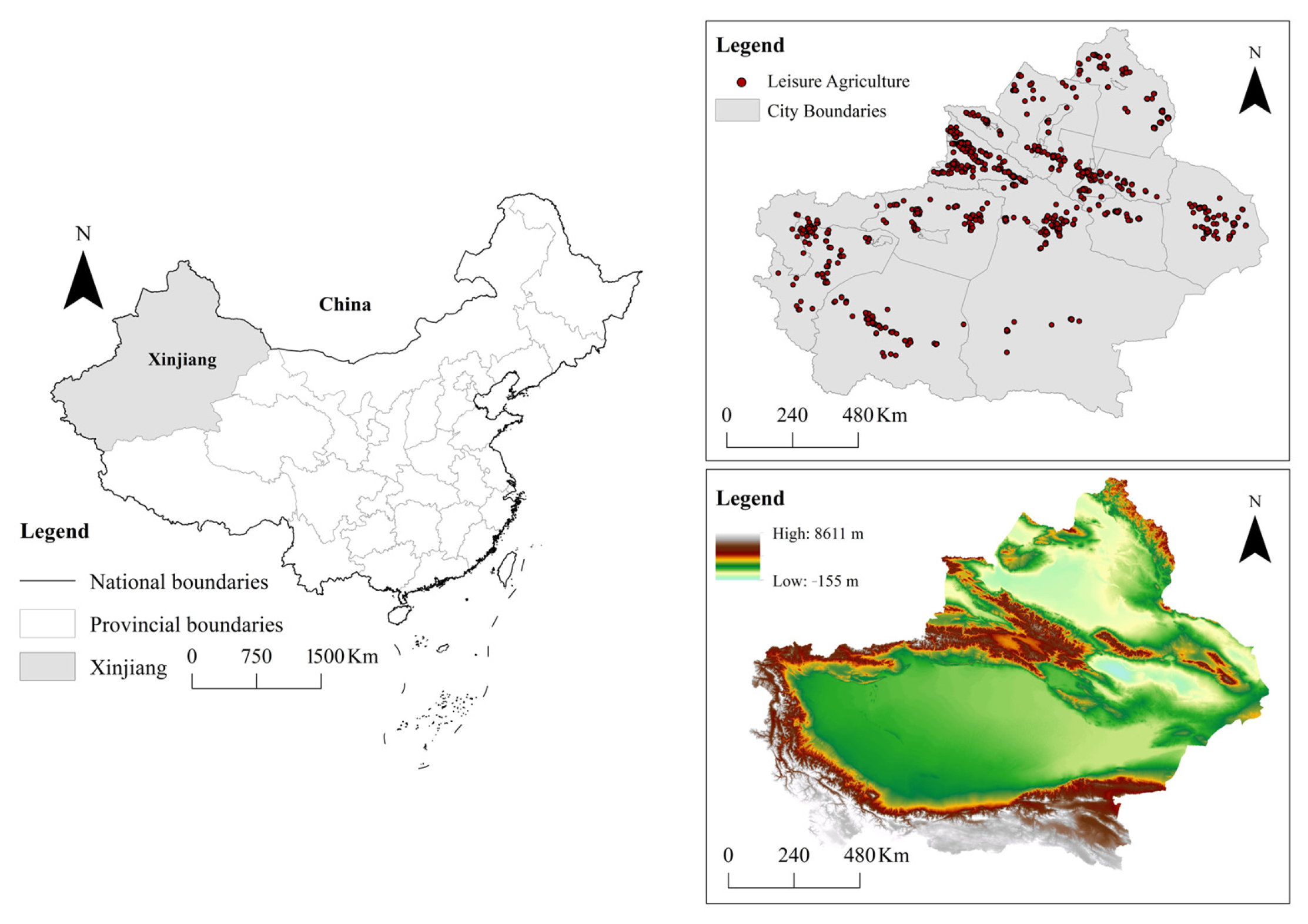


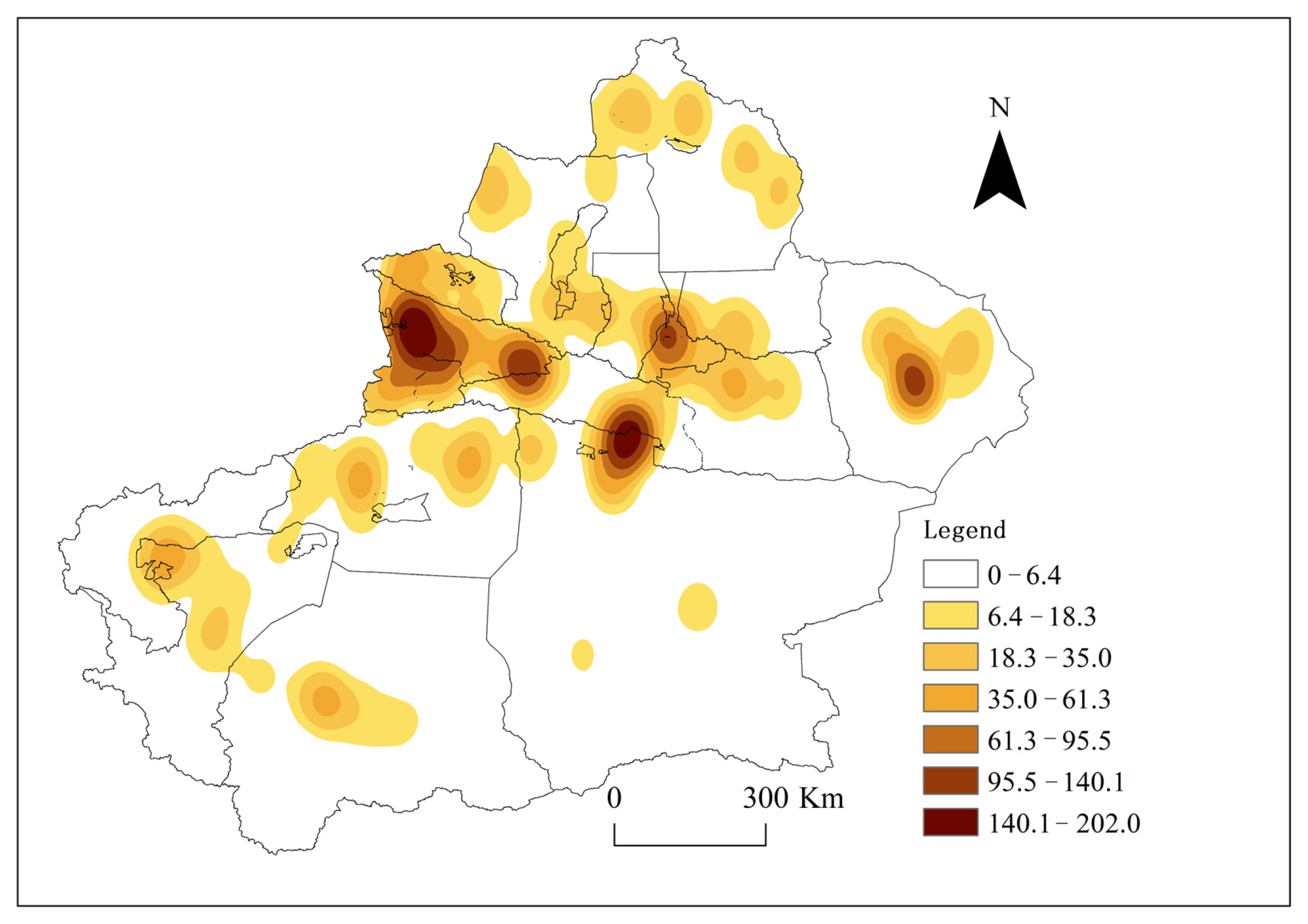
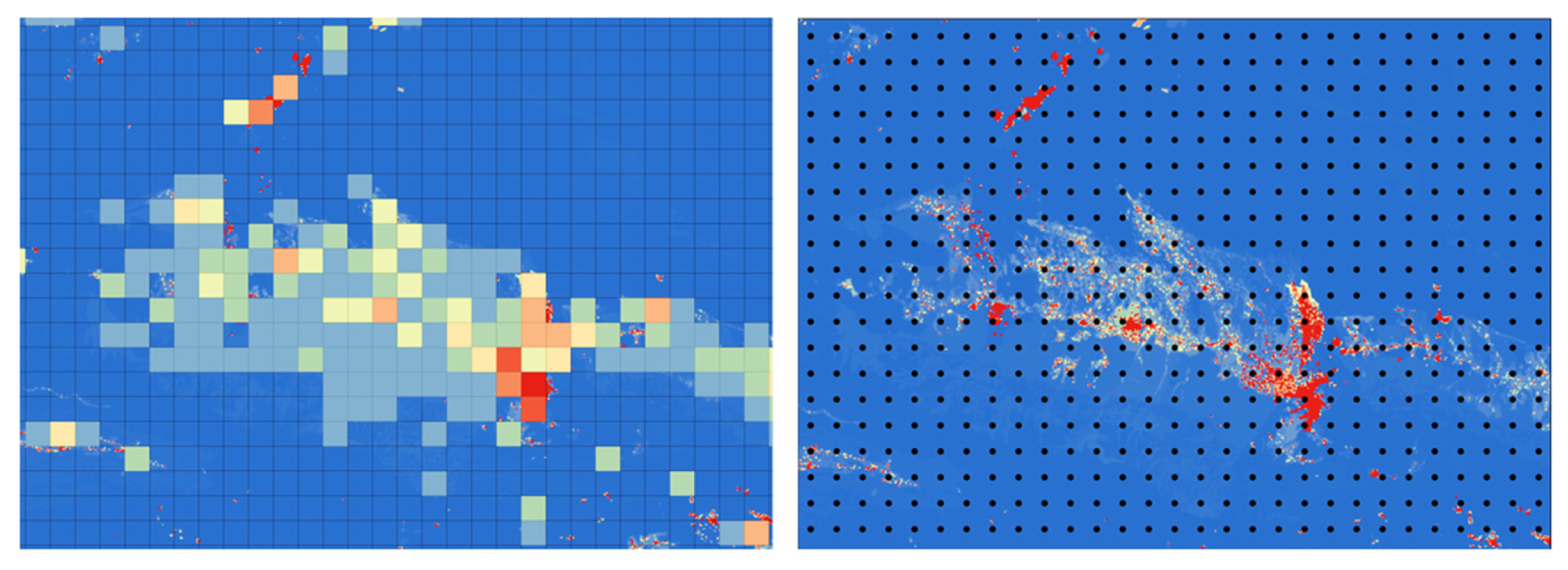

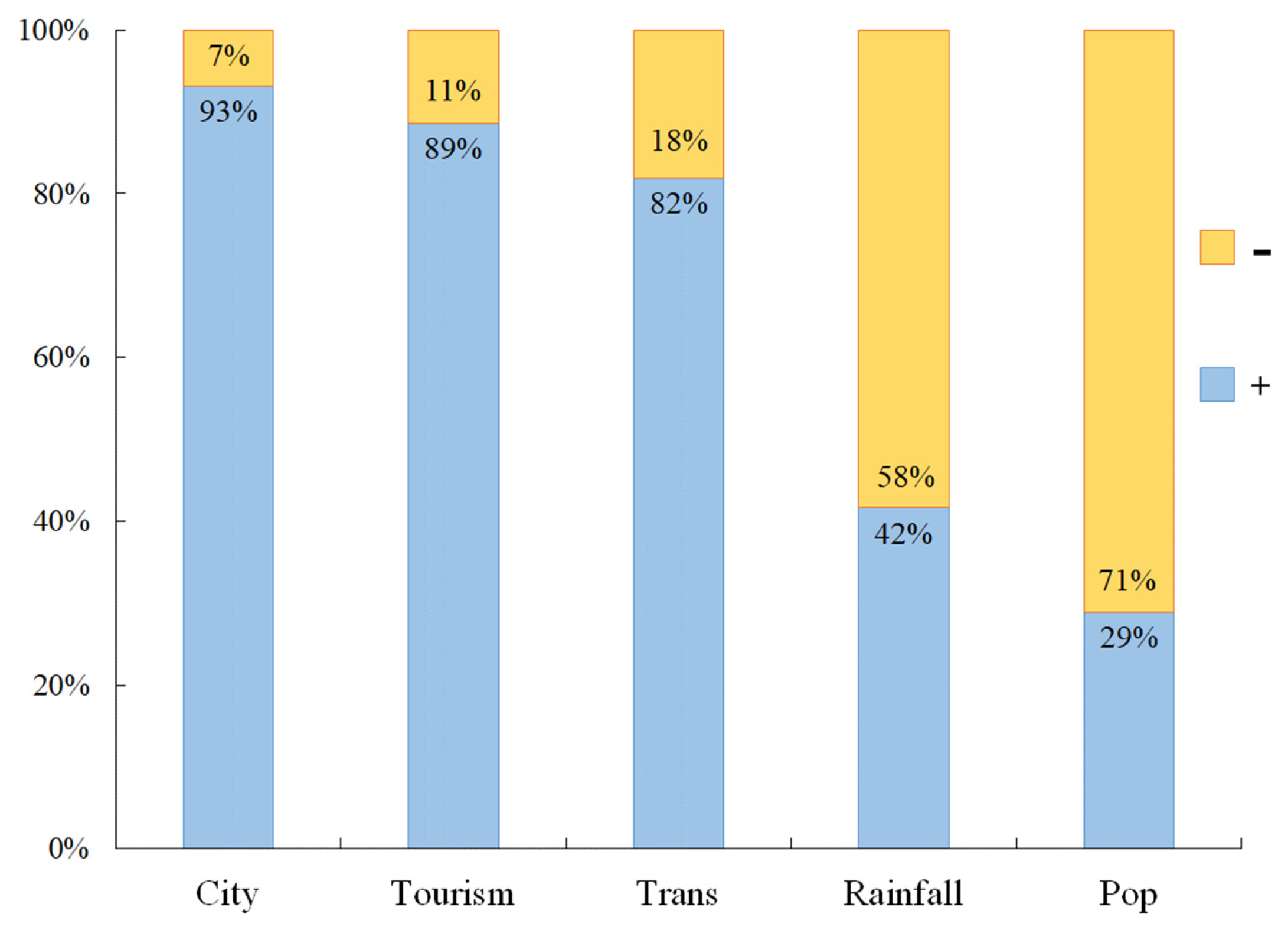
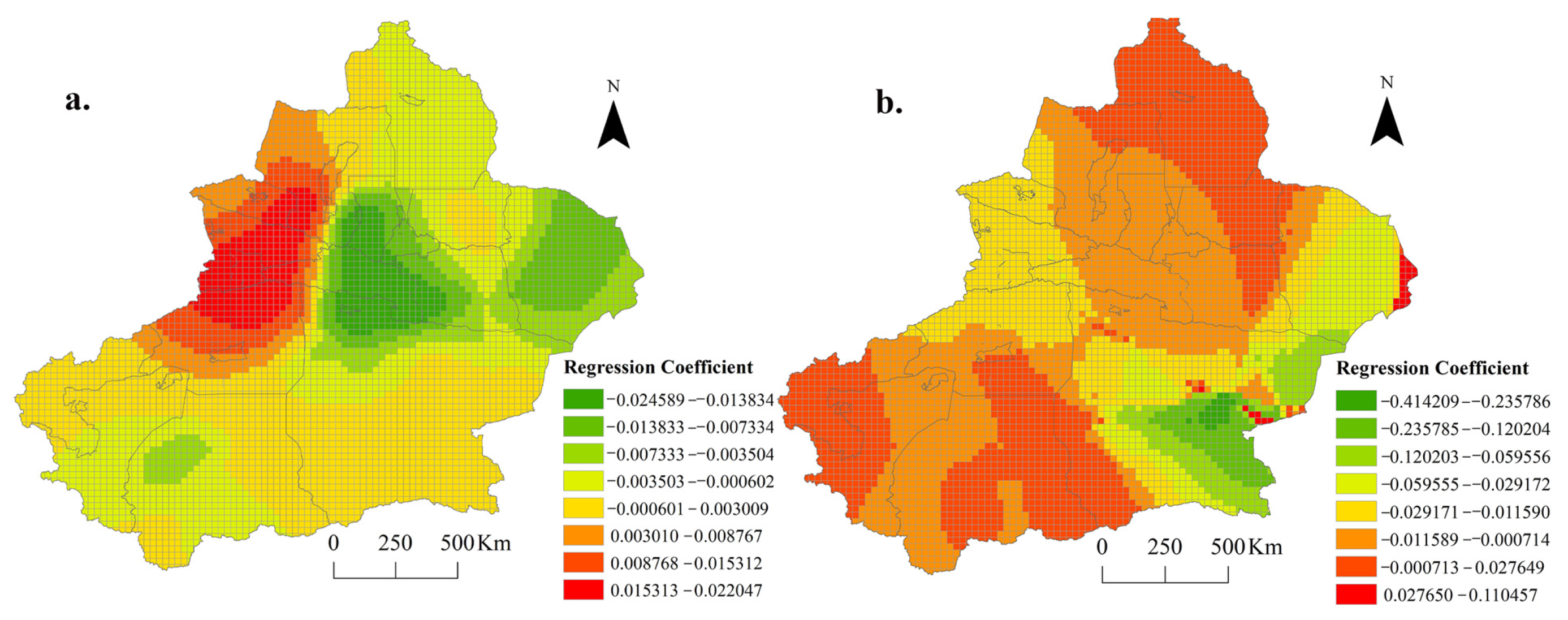
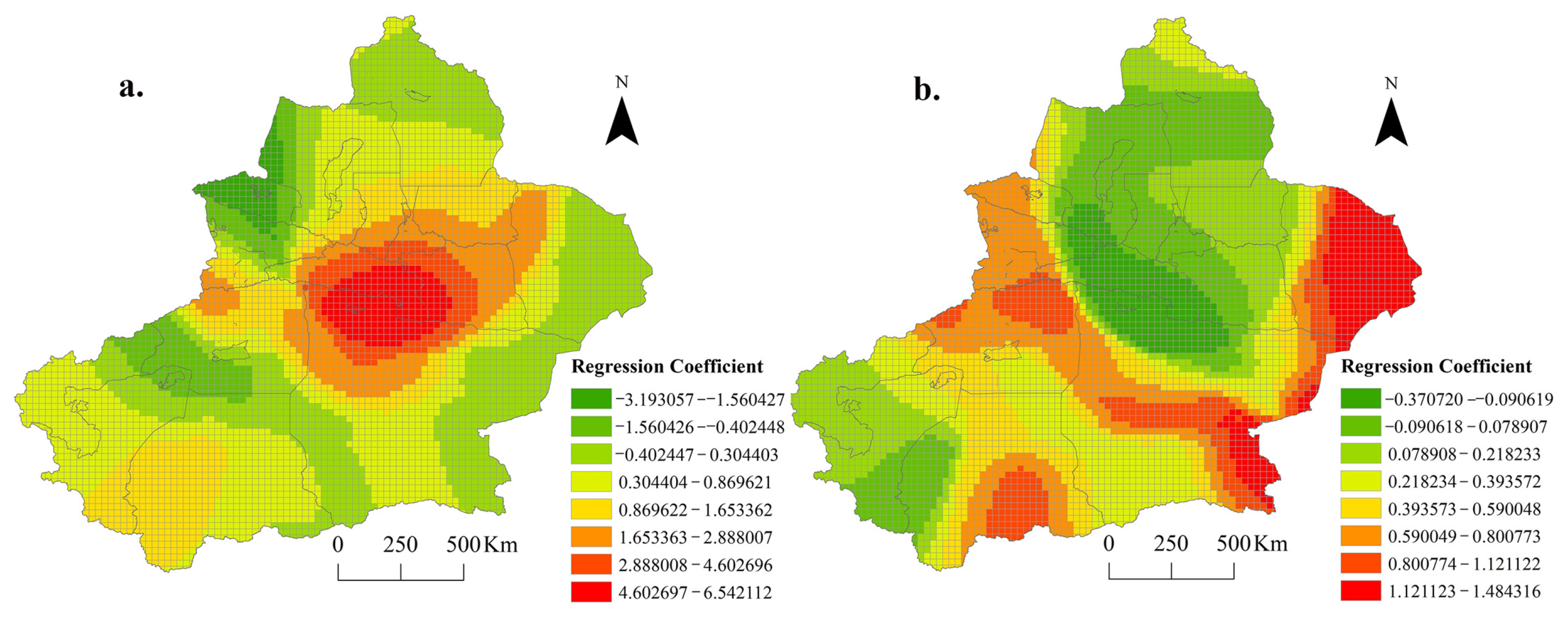
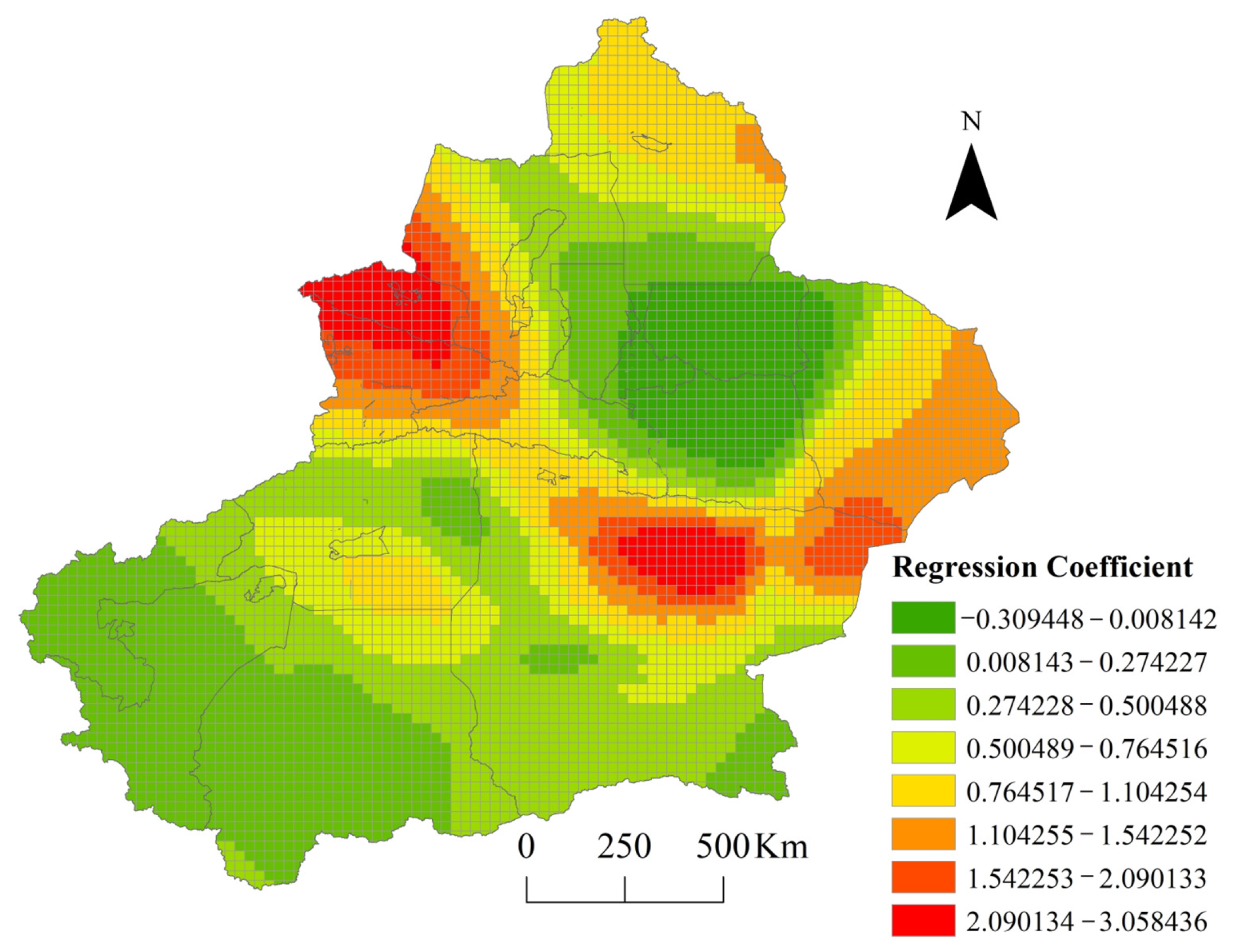
| Data Categories | The Required Data | Source |
|---|---|---|
| Natural factors | DEM (30 m) | Geospatial Data Cloud (accessed on 13 May 2019) (https://www.gscloud.cn/) |
| Rainfall grid data | Resource and Environmental Science, Chinese Academy of Sciences Science and Data Center (accessed on 22 June 2022) (https://www.resdc.cn/) | |
| Socio-economic factors | Population grid data | |
| Economic grid data | ||
| Traffic line vector data | National Geomatics Center of China (accessed on 18 June 2022) (http://www.ngcc.cn/ngcc/) | |
| City point data | ||
| Tourist spot data | Xinjiang Culture and Tourism Department (accessed on 5 June 2022) (http://wlt.xinjiang.gov.cn/) | |
| Leisure agriculture points | 15-March-2022 | Bigemap GIS Office (accessed on 15 March 2022) (http://www.bigemap.com/) Gaode Map (accessed on 15 March 2022) (https://www.amap.com/) |
| Base map data | 8-October-2020 | National Geomatics Center of China (accessed on 8 October 2020) (http://www.ngcc.cn/ngcc/) |
| Index | Value |
|---|---|
| Nearest-neighbor index (R) | 0.179276 |
| Geographic concentration index (G) | 37.62259 |
| Imbalance index (S) | 0.480361 |
| Parameter | Value |
|---|---|
| Center-X | 84.607181 |
| Center-Y | 42.943143 |
| X-StdDist | 2.868473 |
| Y-StdDist | 6.312403 |
| Rotation | 76.27624 |
| Variable | Symbol | Indicator | Max | Min | Mean | Processing Method |
|---|---|---|---|---|---|---|
| Dependent variables | Y | Number of leisure agriculture points | 241.7 | 0 | 120.9 | Number of leisure agriculture points in each grid |
| Independent variables | GDP | Economic factors | 17,647.9 | 0 | 8824.0 | Grid extraction of image-element values of economic grid data |
| Rainfall | Rainfall factors | 6616 | 47 | 3331.5 | Grid extraction of image-element values of rainfall grid data | |
| POP | Population factors | 24,277 | 0 | 12,138.5 | Grid extraction of image-element values of population grid data | |
| DEM | Topographic factors | 8611 | 155 | 4383 | Mesh extraction of image-element values of terrain mesh data | |
| Tour | Tourism resources | 692.7 | 0 | 346.4 | Grid extraction of image-element values of the distribution density of tourist points | |
| City | Urban factors | 178.7 | 0 | 89.4 | Grid extraction of image-element values of town point distribution density | |
| Trans | Traffic factors | 50.2 | 0 | 25.1 | Grid extraction of image-element values of traffic line distribution density |
| Parameter | Width (30 km) |
|---|---|
| Moran’s I | 0.25754 |
| Z-score | 4.832902 |
| p value | 0.000000 |
| Except value | −0.011364 |
| Variance | 0.003096 |
| Variable | Coefficient | Standard Deviation | p Value | t-Value | VIF |
|---|---|---|---|---|---|
| Constant | −3.61629 | 0.550367 | 0.000 *** | −6.57069 | - |
| Pop | −0.00591 | 0.00218 | 0.070 ** | −2.71067 | 2.315714 |
| DEM | −0.00037 | 0.000197 | 0.160 | −1.87822 | 1.123668 |
| GDP | −0.00138 | 0.001266 | 0.275 | −1.09105 | 2.448987 |
| Rainfall | 0.004332 | 0.000275 | 0.000 *** | 15.7314 | 1.116986 |
| Trans | 1.601967 | 0.111243 | 0.000 *** | 14.40056 | 4.46111 |
| Tours | 0.045394 | 0.010466 | 0.000 *** | 4.337415 | 2.743930 |
| City | 0.445548 | 0.04207 | 0.000 *** | 10.59072 | 4.797246 |
| R2 | 0.443132 | ||||
| Adjusted R2 Koenker (BP) | 0.442327 860.82529 * |
| Parameter | Value |
|---|---|
| Bandwidth | 260,120.3232 (m) |
| Residual squares | 588,319.0641 |
| Effective number | 122.98925 |
| Sigma | 11.158481 |
| AICc | 36,210.456585 |
| R2 | 0.841424 |
| Adjusted R2 | 0.837014 |
| Parameter | Value |
|---|---|
| AIC | 42,107.83 |
| AICc | 42,107.87 |
| F-stat | 550.21 |
| F-prob | 0.00 |
| Wald | 806.26 |
| Wald-prob | 0.00 |
| K (BP) | 860.83 |
| K (BP)-prob | 0.00 |
| Sigma2 | 345.73 |
Publisher’s Note: MDPI stays neutral with regard to jurisdictional claims in published maps and institutional affiliations. |
© 2022 by the authors. Licensee MDPI, Basel, Switzerland. This article is an open access article distributed under the terms and conditions of the Creative Commons Attribution (CC BY) license (https://creativecommons.org/licenses/by/4.0/).
Share and Cite
Chang, Y.; Li, D.; Simayi, Z.; Ren, Y.; Yang, S. Spatial Distribution of Leisure Agriculture in Xinjiang and Its Influencing Factors Based on Geographically Weighted Regression. Sustainability 2022, 14, 15002. https://doi.org/10.3390/su142215002
Chang Y, Li D, Simayi Z, Ren Y, Yang S. Spatial Distribution of Leisure Agriculture in Xinjiang and Its Influencing Factors Based on Geographically Weighted Regression. Sustainability. 2022; 14(22):15002. https://doi.org/10.3390/su142215002
Chicago/Turabian StyleChang, Yao, Dongbing Li, Zibibula Simayi, Yiwei Ren, and Shengtian Yang. 2022. "Spatial Distribution of Leisure Agriculture in Xinjiang and Its Influencing Factors Based on Geographically Weighted Regression" Sustainability 14, no. 22: 15002. https://doi.org/10.3390/su142215002
APA StyleChang, Y., Li, D., Simayi, Z., Ren, Y., & Yang, S. (2022). Spatial Distribution of Leisure Agriculture in Xinjiang and Its Influencing Factors Based on Geographically Weighted Regression. Sustainability, 14(22), 15002. https://doi.org/10.3390/su142215002






